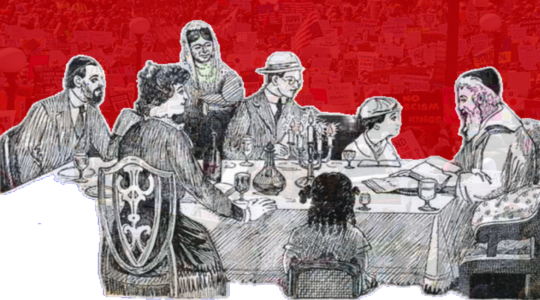In the Jewish tradition, the 10 days stretching from Rosh HaShanah (the Jewish New Year) to Yom Kippur (the Day of Atonement) are a time of judgment. In the metaphoric imagery of the liturgy, on Rosh HaShanah all humans are judged and their fate for the coming year is recorded by God; on Yom Kippur Divine judgment is sealed. “Who by fire, who by water,” the opening words of Leonard Cohen’s well-known song, are direct quotes from a central prayer of the Jewish High Holy Days that also asks, “Who shall live and who shall die?” This is the existential angst underlying the Days of Awe.
Reinforcing the theme of impending judgment, the final service of Yom Kippur is called Ne’ila, “the closing” of the gates of heaven when God’s judgment is finalized. As day turns to night, the ark housing Torah scrolls is left open for the hour-long Ne’ila service, symbolizing the hope that God remains receptive to prayers and supplication. And then at the end of Ne’ila, the ark is closed, and so too metaphorically is the Book of Judgment.
In recent years, a new Ne’ila custom has swept non-Orthodox synagogues. Congregants are invited to make their way from their seats to stand for a few moments before the ark. In large synagogues, hundreds of people snake their way through the aisles to avail themselves of the opportunity. A Reform rabbi in Washington, D.C., reports his amazement at watching high-powered government officials, well-educated professionals and academic experts, among others, join the procession. So many, in fact, seek to take their turn that the synagogue extended the Ne’ila service.
There’s no way to know what goes through the minds of the multitudes when they stand before the Torah scrolls. Are they having a personal encounter with God? Do they petition God for healing or success? Are they asking forgiveness for missteps or reconnecting in some way with the religion of their ancestors? Is the time spent before the ark devoted to meditation?
What is visible, though, is how much of this new pageant is family-oriented. Entire families approach the ark together, spread a prayer shawl (tallit) around their shoulders, and bow their heads. Parents make sure to retrieve their young children from youth services to have them present. Elderly and infirm family members are aided by their kin so they too can join. Family configurations of all sorts are represented. And a significant proportion who stand before the ark can be seen shedding tears.
For the most part, rabbis are heartened by this outpouring of people and emotions. It represents a departure from longstanding practices in non-Orthodox synagogues where congregants typically have left well before the end of the day’s services. The majority have tended to arrive late and walk out early on Yom Kippur, with the prime hours of participation running from 11 a.m. to 1 p.m. or so, a time when the Torah is read, the Yizkor (remembrance for the deceased) prayer is recited, and the rabbi delivers a sermon. The day-long immersion in prayer, in short, was reduced to but a few hours. That has been changing, though, and the opportunity to participate actively in the Ne’ila procession as twilight comes is a good part of the reason why many worshippers return to their synagogues later in the day.
‘In the new Ne’ila custom, entire families approach the ark together, spread a prayer shawl around their shoulders, and bow their heads.’
Not everyone, to be sure, sees this new practice as an unalloyed boon. Some rabbis regard the procession as a distraction from the Ne’ila liturgy set forth in holiday prayer books. That service is recited publicly and aloud, but may become, as one rabbi put it somewhat cynically, “background music for personal supplications.” Traditionalists contend that the practice distorts the original purpose of Ne’ila, and for that matter the entire High Holy Day liturgy. From a traditional perspective, the supplication of individuals is integrated into and elevated by communal worship. Isn’t the purpose of the day, they ask, to mesh individual petitions with the outpouring of collective prayers? Nor is it necessary to seek out God’s attention by standing before the ark, they contend. God hears the prayers of all, no matter where they are located.
And yet, it’s quite evident that the Ne’ila practice has touched the hearts of many Jews. It offers a very personal culmination of a 10-day period designed to lift individuals out of their quotidian lives to concentrate on what is most important to them. As the Days of Awe come to a close, Jews of all kinds now have the opportunity to express in their own words what is in their hearts, and to do so as they stand inches from the ark housing Torah scrolls. It’s hardly surprising this becomes a peak moment of the High Holy Days for many participants.
The invitation to stand before the ark, moreover, is extended to all. Everyone is equally welcome to participate; social hierarchies fall. In the estimate of a Midwestern Conservative rabbi, 70 percent of attendees take advantage of the opportunity. Another Conservative rabbi notes her thrill at the opportunity the Ne’ila custom creates to “break down the [figurative] moat” separating synagogue officiants from the lay worshippers. All have a place in front of the ark. The egalitarian aspirations of the synagogue are put into practice.
Perhaps most profoundly, the new Ne’ila custom enables congregants to bring their ultimate concerns together with their religious traditions. A Reform rabbi wisely observed to me that the family is the most important arena of “sacredness in the lives of most Jews today.” To express that through religious ritual, families are most likely to attend synagogue prayer services at moments of celebration or sorrow— to name a newborn, mark the coming of age at a bar/bat mitzvah, receive a blessing on the eve of a wedding or mourn at a time of death. Coming before the ark during the closing moments of the year’s most sacred day provides an additional opportunity for families to embrace one another in all their vulnerability as they offer a private prayer in a very public setting.
Jack Wertheimer, professor of American Jewish History at the Jewish Theological Seminary, is the author of “The New American Judaism: How Jews Practice their Religion Today,” recently published by Princeton University Press.
The New York Jewish Week brings you the stories behind the headlines, keeping you connected to Jewish life in New York. Help sustain the reporting you trust by donating today.




